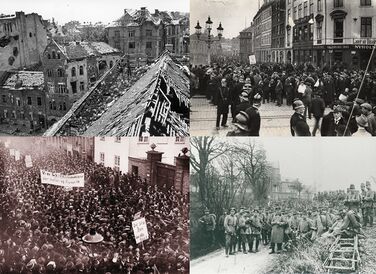Littish Civil War
| Littish Civil War | |||||||
|---|---|---|---|---|---|---|---|
 Clockwise from top-left: Ruins of Frankerup, Protesters before the Gistrup Massacre, Republican Soldiers in Aadal, Malskic Protesters in Karlino | |||||||
| |||||||
| Belligerents | |||||||
|
|
| ||||||
| Commanders and leaders | |||||||
| |||||||
| Strength | |||||||
|
| ||||||
| Casualties and losses | |||||||
|
| ||||||
|
Civilian: ~738,000 killed
~1,063,000 total killed | |||||||
The Littish Civil War (Littish: Den Littiske Borgerkrig) was a civil war fought in Littland between 1910 and 1913 between Republican and Socialist forces.
Background
Following the death of Helge III, Walter Nordskov becomes Regent of an interregnum government on 3 February 1910. Nordskov was openly and staunchly anti-socialist and begins to repeal workers rights and trade union protections as a constitutional was found that allowed such actions during a Regency as the King weren't there to approve/veto the action. Socialists across the country voice their disapproval and protests are organized in major cities. Trade unions declare a campaign for 'national solidarity' and strikes begin, until Nordskov reinstates worker and union rights.
Gistrup Massacre
As part of the national solidarity campaign, several trade unions in Gistrup declare strike on 13 March and marches are prepared for the following days. On 15 March, police officers along with reinforcements have arrived in Gistrup and begin to crack down on the marches and the strikers. This comes to a head outside the head office of Gistrup Metallurgy Workers Union, where police draw their weapons, several strikers are shot dead and chaos erupts in the city, order is only fully restored by midnight. In total 48 workers were killed by the police and they become martyrs for socialists across Littland, representing their struggle against the 'Tyrant Regent'. Nordskov declares martial law on 20 March 1910 as riots intensify across the country.
Storming of Tinghuset
The storm happened on 9 April 1910 as socialists in Kaslund begin to march on Helge Square to protest against the governments repealing of workers rights legislation. The protest turns hostile as the protesters clash with police and shots are exchanged, leading to further violence and the protest turns into a riot. More radical elements of the protest rally around 600 people and march on Tinghuset. Around this time Regent Walter Nordskov is evacuated to Frankerup along with the government. Socialists successfully take control of Tinghuset and in total, 86 people die as a result of the clashes during the day. The following day, 10 April 1910, The Social Republic of Littland is declared as the revolutionaries take full control of Kaslund signaling the start of the civil war.
Combatants
Socialists
Republicans
Nationalists
Foreign Volunteers
Warfare
Initial Stages
Sønderland Campaign
Malskic Revolt
Stalemate
Aadal Pocket
Battle of Frankerup
Socialist Collapse
Aftermath
Death toll
Recovery Era
Legacy
Literature
Media
The 2010 movie Between Brothers, released on the 100th year anniversary of the Gistrup Massacre, depicts the civil war, including major battles and skirmishes, as well as the societal changes Littland was going through via the main characters.
Timeline
| Date | Event |
|---|---|
| 2 February 1910 | Death of King Helge III |
| X X 191X |